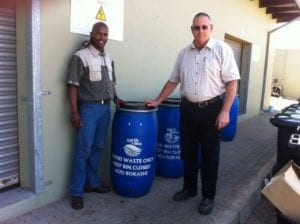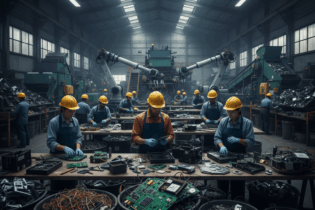Over the past few months, Maropeng has embarked on an exciting new recycling initiative: the bokashi process. Maryke Foulds speaks to Robere Brockman, maintenance manager at Maropeng, about its implementation.
Bokashi is a fermentation and composting process that diverts food waste from landfill and upcycles it into a high-value nutrient feed for gardening and agriculture. It also saved 435 kg of CO2 emissions when compared to dumping in a landfill. How were you introduced to the bokashi recycling process? A few months ago we met with a representative from Pro-Biotic, who took us through the bokashi process. We looked at pricing and where we could set up the drums and got the process under way. Since the start, we have had a number of meetings with Pro-Biotic for training as well as advice. We decided on this type of recycling as it meets a need at Maropeng and can assist the surrounding community. Please explain the process We currently have 15 bokashi drums that are rotated between various venues at Maropeng and Sterkfontein Caves. We didn’t need to build anything special, merely brought the drums in. Prior to installing the bokashi system at Maropeng, food waste was going to landfill. In addition, organic landscape matter was also being sent to landfill. This has now changed due to the bokashi process.Bokashi is a method that uses a mix of microorganisms that cover food waste to decrease smell. Food waste is layered with bokashi in anaerobic digesters (closed bins). The bokashi then starts a fermentation process, stopping rotting and eliminating the production of greenhouse gases. Following fermentation, the fermented matrix can then be safely composted trenched or fed to composting worms. A key advantage of the bokashi system is that all food waste including cooked and uncooked food including meat, bones, sea food and dairy can be processed and quickly composted, safely and without odours. The bokashi system fits into the waste hierarchy at the second level of recycling and nutrient recovery.
In addition, measurement is easily obtained and this leads to reduction in food waste. Ultimately, the system diverts food waste from landfill and upcycles it into a high-value nutrient feed for gardening and agriculture. The anaerobic then composting process saves 435 kg CO2 emissions vs dumping into landfill. In addition, separating food waste at source allows for 32% increase in dry recyclable volumes. Is maintenance required? No particular maintenance is required, but training on a daily basis to ensure drums in the four kitchens are kept closed at all times. The drums are heavy when full and need to be man-handled to the storage area for the two weeks. Then they need to be transported to the compost heap. Then, after they are emptied, they need to be washed out. Where is the composting product used? Maropeng currently uses the recycled material to feed its gardens and is assisting Maloney’s Eye School with feed for its vegetable gardens. Maropeng plans to extend the project in the coming months to supply feed for vegetable farmers in the area who supply Maropeng with fresh produce.







